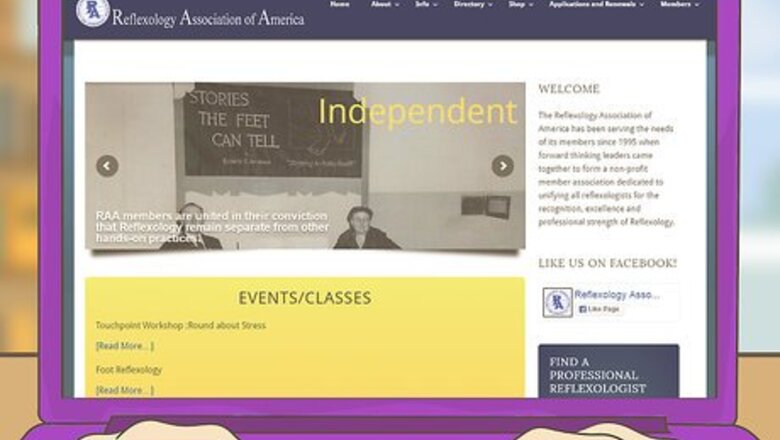
views
Researching Requirements and Preparing

Learn the requirements in your geographical area. Some states allow you to practice as a reflexologist without any certification or license, while other states require certification, and/or as many as 1,000 hours of instruction and passing a written licensing exam. Look up the requirements for the state, country, or geographical area(s) where you will want to practice. Contact the Reflexology Association of America (RAA) or your state health department to learn what your local requirements are. You must be 18 or older to become a reflexologist.
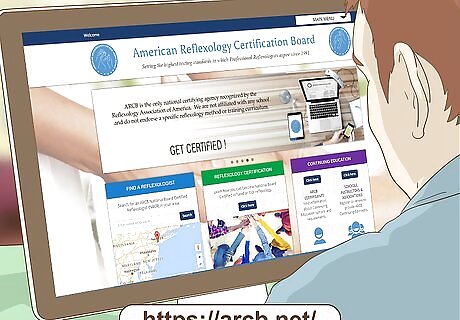
Know if you need to get certified. While there is no degree program in reflexology, there are certification programs. In many jurisdictions, you must meet certification requirements before you can practice reflexology. For example, the American Reflexology Certification Board (ARCB) requires that foot reflexology training includes a minimum of 110 hours of hands-on instruction or a combination of college-level coursework in physiology and anatomy with hands-on training. There are different certifications for the foot and hand. Generally, you must pass the foot exam before you can begin the hand certification. Even if your state does not require certification, you may want to become certified anyway. Employers may prefer certified practitioners.

Ask respected reflexologists where they studied. Speak with some practitioners you are comfortable with and respect. Ask if they can tell you about their educational experience, some background and insight into the industry, and the quality of training offered by various institutions.

Set aside tuition money. Most reflexology schools can be completed in 6 to 12 months. A program usually costs around $1,500 to $3,500. Start saving now, or consider applying for a student loan if you need financial assistance. Costs and requirements may vary between geographical areas. You will probably also need to purchase a massage table or massage chair, and possibly textbooks. This can cost several hundred dollars.
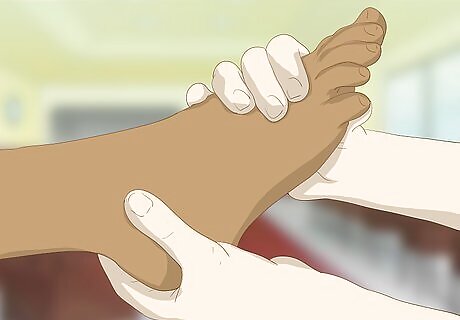
Get reflexology treatments to learn what you like. Go to several reflexologists for treatment to get an idea of different techniques. Not every reflexologist conducts a session in exactly the same way. If possible, treat yourself to each form of reflexology. It might help you decide if you want to specialize in foot, hand, or ear reflexology. If you encounter a professional whose practice you enjoy more, ask them about their education and training.
Choosing a Reflexology School or Program

Create a list of reflexology schools near you. Search the Yellow Pages or gain access to a computer and look for schools online. Search for reflexology schools in your area - narrow your search using your city or zip code or searching for accredited schools only. Call the schools or visit their websites to gather information and ask them to send you information about their programs. Decide if you want to focus on one type of reflexology (hand, foot, or ear), or learn it all, then locate the appropriate program. There are hundreds of websites on the Internet that offer reflexology training. You must be discerning when you choose educational resources that will help you begin a new career as a reflexologist.

Check out the school’s curriculum. Your reflexology school should provide training in the history, theory, practice and techniques of reflexology. They should cover class work in anatomy and physiology, reflexology maps of the feet, hands, and/or ears, eastern and western modalities, ethics and professional standards, marketing and business, and how to customize sessions to clients’ specific needs. Avoid any program that does not include hands-on training. You can’t learn the art of reflexology without real practice. Your program should have supervised clinical practice.

Ask reflexology schools if you may conduct informational interviews. Contact schools to request discussions with their instructors and past graduates. This can help you determine if the structure and approach of the program will meet your needs.

Inquire about the number of practice hours you’ll be required to complete. Some reflexology schools build practice hours into their coursework. Others ask that you practice outside the school environment and submit proof of practice hours through a feedback form from your patients. Find out what your school requires so you can plan accordingly.

Determine if the school addresses the topics covered on the final examination. If you will need to take a licensing or certifying exam to practice reflexology, look for an outline or “blueprint” of what’s on the exam. You can find this on the website of the organization that gives the exam. Choose a school that adequately prepares you for the examination you will be taking. For example, an examination may include categories that cover assessment and evaluation, treatment plan development, treatment skills application, and topics related to professional responsibility and ethics.
Getting Your Reflexology Certification
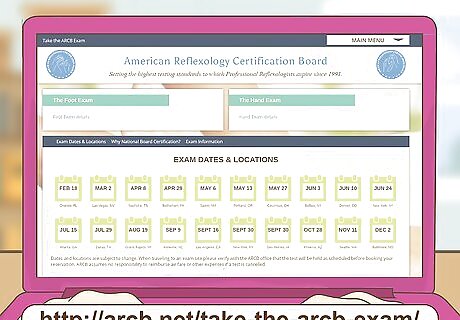
Apply to take the certifying examination. Find out if you need to submit any documentation, such as a certificate of program completion, a CPR certification, proof of practice hours, or proof of citizenship. You can apply to take the exam and pay the exam fee on the ARCB website at https://www.arcb.net/general-7. The foot exam costs $295 and the hand exam costs $150.

Study for and take the licensing examination. Review your reflexology program materials, study with others, or find additional study resources. Before graduating from your reflexology program, ask your instructors to direct your focus to the specific information covered by your jurisdiction's certifying examination. Some study materials may be available from the ARCB on their website. You will likely need to take separate exams for hand reflexology and foot reflexology. Exams are only offered at certain times and locations, so plan ahead.

Pursue continuing education. If you are certified, you will have to gain at least 12 hours of continuing education every 2 years. You can get these hours through independent study or coursework in the field. Visit the ARCB’s source for continuing education to keep your knowledge fresh and up to date, at http://arcb.net/continuing-education/certificants/.
Gaining Practice in the Field

Join an established reflexology practice. You won’t have to worry about start-up costs and marketing if you join a practice, giving you the time you need to further develop your skills and interact with other reflexologists. Reflexologists can practice at chiropractor’s offices, fitness centers, salons, and other health and wellness centers.

Start your own practice. Establishing your own private practice requires more marketing effort, but allows you to establish your own treatment philosophy, prices, and hours of operation.

Consider choosing an adventurous position. Apply for positions at hotel spas or on cruise ships if you’re open to traveling.

Join a professional organization. Consider joining the RAA or getting another professional membership. These organizations often offer networking opportunities, educational events or resources, and an online community presence.















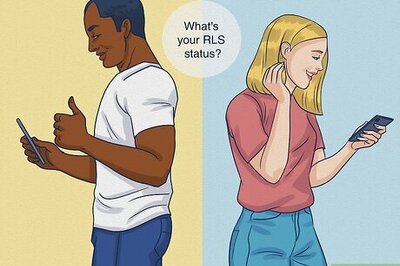

Comments
0 comment